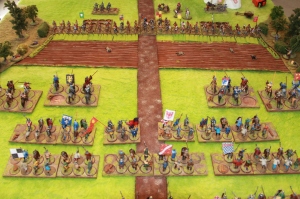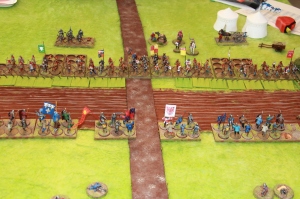Before we moved, Lead Adventure Forum pal Mick_in_Switzerland invited me over for a farewell game. As he is working on an Agincourt project in 28mm, we decided to have a go at this battle. Both of us having just bought Lion Rampant, we wanted to see how the rules would work with a set-piece battle.
Mick prepared the two forces on the basis of his historical research. At first glance, this made the English look like a ‘happy few’ indeed: Six English stood against sixteen French units! However, the English had not only high quality units (four units of Expert Archers and two of Foot Men-at-Arms), but also the terrain working for them: The archers were behind stakes, which would count as cover in melee, and in front of the English lines lay the ploughed fields, which counted as rough terrain and would half the movement of approaching French units. Still, I was pessimistic about the English prospects, having seen in the El Cid game what Mounted Men-at-Arms could do.

For the first game, Mick played the French. He decided to recreate the historical strategy and attacked in waves. The first wave comprised of two units of Mounted Men-at-Arms and two Mounted Serjeants. Due to activation misses and the ploughed fields, they advanced rather slowly and gave the archers plenty of opportunity to shoot. To our shock, the attacked ended with the first wave completely annihilated by a rain of arrows, while the English lost only two archers.

The French second wave was made up of two units of Foot Serjeants on the flanks and two units of Men-at-Arms in the centre. Only the Marshall of France’s group of knights managed to make it through the archer’s killing zone, heroically plunging into the English knights and causing some casualties before finally succumbing.
In view of those appalling losses – forty casualties against four on the English side – the French decided not to launch their third wave and conceded defeat.
In the second game, I played the French. We had the idea that I should try to do a better job than the historical French and devise my own strategy instead of following the historical order of events. I decided to use the Crossbowmen more offensively and get them in range to shoot as soon as possible. I covered them with Foot Serjeants and advanced. As was predictable, the Serjeants were shot to pieces quickly, but at least they gave the crossbows a chance to get in range. While their shooting did some damage to the archers, they couldn’t withstand the arrows for long and were gone before they did substantial damage. The English archers were still strong enough to easily destroy my cavalry before it could reach the English lines. At this point, I conceded defeat.
Mick and I were impressed how the rules handled a scenario like this. Agincourt certainly would be challenge for most rules, as the French have a huge superiority in numbers while the role of the English is rather static. However, the activation mechanics makes playing the English interesting and the way the rules handle rough terrain makes the French attack really difficult. For a set of rules that stresses entertainment and fun, Lion Rampant certainly delivered a very historical result!
After some snacks to recover from the shock of the bloodbath, we had a go at two of the scenarios in the Lion Rampant rulebook. We used the English and French retinues listed in the book and played ‘Meeting the Neighbours’ and ‘The Messenger’. Both games were great fun and we started to discover some of the tactic possibilities of the rules. One game was won by me, the other by Mick – interestingly, both when playing the English. I guess the French were demoralised after their defeat at Agincourt.
Again many thanks to Mick for his hospitality; this was a great and fun afternoon!
One thought on “Agincourt with Lion Rampant”